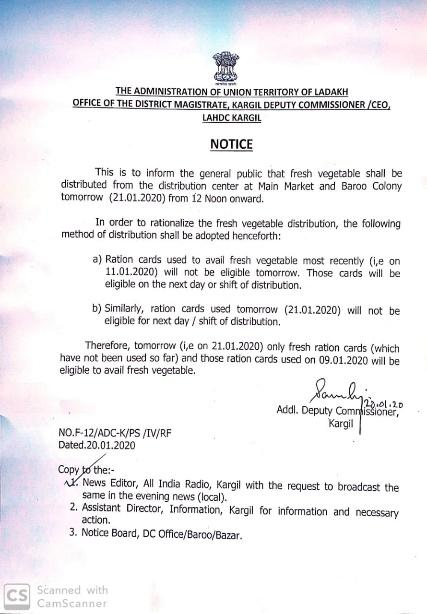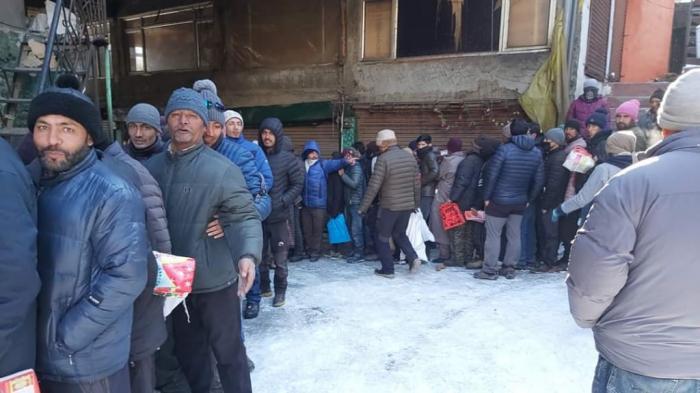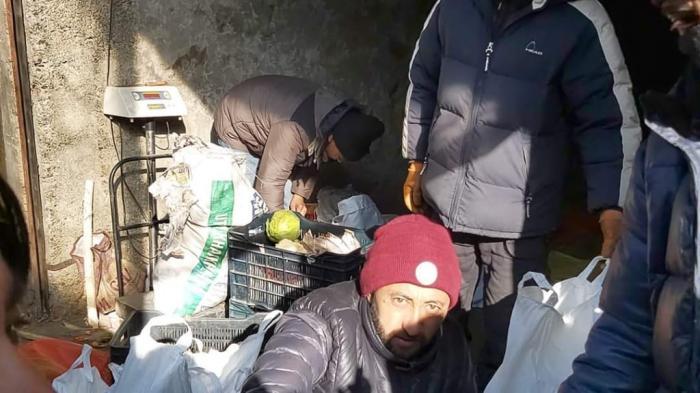Locals Enraged after Vegetables Rationed Amid Short Supply

New Delhi: For the last 20 days, Ali Waziri has been surviving on dal (lentils) and a few dry vegetables he had stored before winter arrived in Kargil. He is unable to buy vegetables because he doesn’t have a ration card. Waziri works in the city while his family lives about 40 kilometres away, in a village named Suknoo.
“To buy vegetables, I need to have a ration card. And for that, I need to go home and get my father’s ration card. Our stock of dry vegetables is about to end and because of my hectic work schedule its getting difficult for me to take an off and go home,” Waziri told NewsClick.
Waziri is not the only one. There are many locals who work in the city, away from their home. The city has outsiders too, those who work as government employees, teachers, and labourers. They are unable to buy vegetables because they are not eligible for a ration card.
An order by the District Magistrate of Kargil on January 20 made a ration card mandatory for the general public to buy vegetables. The order said: “In order to rationalize the distribution of fresh vegetables, a method of distribution shall be adopted henceforth according to which ration cards used to avail fresh vegetables most recently (i.e. on 11.01.2020) will not be eligible tomorrow. Those cards will be eligible on the next day or shift of distribution.”

Locals enraged:
In Kargil, long queues can be seen outside government vegetable outlets with people showing their ration cards to buy produce. As per locals, they get between three to four kilograms of vegetables for Rs. 300 rupees. They are not of their choice but as decided by the vendor. After buying vegetables, they say their ration card is updated with another date -- usually 20 days later-- when they can return to buy vegetables.
“For 300 rupees, we are given around 10 onions and tomatoes each, two cauliflowers and another vegetable,” a local who wishes to stay anonymous told NewsClick.
Kargil remains cut-off from the world during winters, and locals stock up with dry vegetables which would last between three and four months when used intermittently. Locals would usually rely on vegetables brought from Kashmir, but, for the first time, people are having to show ration cards just to buy vegetables.

“Generally, supply of vegetables is low during winters. But, this time, there has been a substantial shortage of vegetables. This trend of showing ration cards has also happened for the first time,” said Sajjad Hussain, a prominent activist from Kargil.
Villages and far flung areas neglected:
There is also a problem of access. The vegetable distribution centre has been set up in the main city of Kargil, neglecting villages and far flung areas. The order mentioned, “This is to inform the general public that the fresh vegetable shall be distributed from the distribution centre at Main Market and at Baroo Colony tomorrow at 12 Noon onward.”

There are 15 blocks in Kargil including Sankoo, Dras, Shakar Chiktan and Shargole among others. These blocks are far from the main city. “We insist that the administration opens up government distribution centres at each block. Villages and far flung areas don’t have access to vegetables. We also request the administration to roll back the ration card decision as it is creating difficulties for the locals and outsiders, equally,” said Haaji Abbas Balti, the President of Merchant Association Kargil.
Outsiders living in Kargil who are mostly from Kashmir, Leh and Uttar Pradesh are having a hard time since they don’t have access to vegetables and are not comfortable with the local food. “This is ridiculous and has happened for the first time. We are not getting vegetables. It is affecting us outsiders a lot as our taste buds are not comfortable with the local food,” said a non-local working in Kargil.
Get the latest reports & analysis with people's perspective on Protests, movements & deep analytical videos, discussions of the current affairs in your Telegram app. Subscribe to NewsClick's Telegram channel & get Real-Time updates on stories, as they get published on our website.















